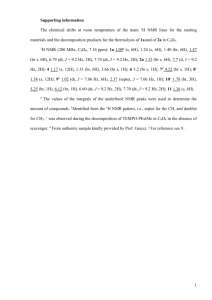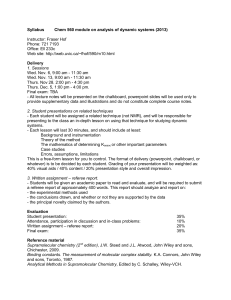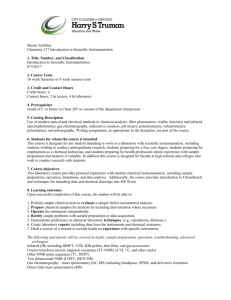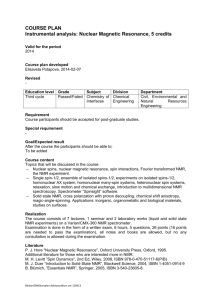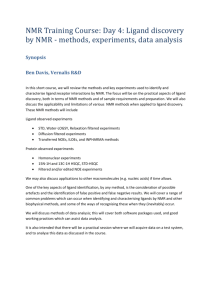Nuclear Magnetic Resonance Studies of Protein
advertisement
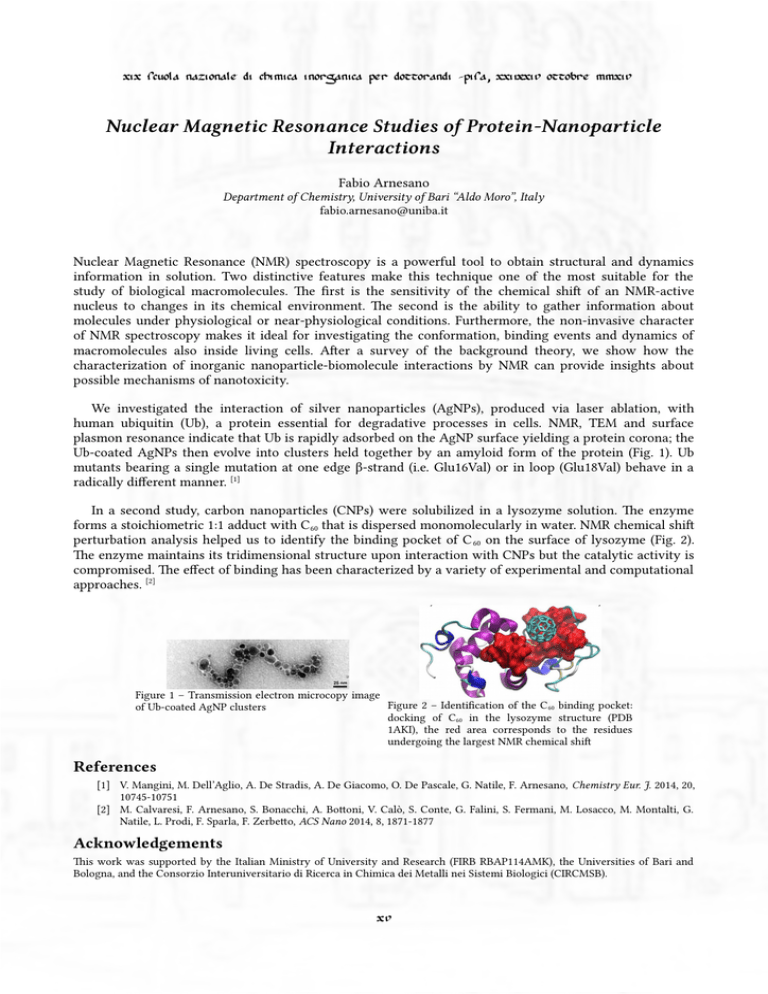
xix scuola nazionale di chimica inorganica per dottorandi ­ pisa, xxii­xxiv ottobre mmxiv Nuclear Magnetic Resonance Studies of Protein-Nanoparticle Interactions Fabio Arnesano Department of Chemistry, University of Bari “Aldo Moro”, Italy fabio.arnesano@uniba.it Nuclear Magnetic Resonance (NMR) spectroscopy is a powerful tool to obtain structural and dynamics information in solution. Two distinctive features make this technique one of the most suitable for the study of biological macromolecules. The first is the sensitivity of the chemical shift of an NMR-active nucleus to changes in its chemical environment. The second is the ability to gather information about molecules under physiological or near-physiological conditions. Furthermore, the non-invasive character of NMR spectroscopy makes it ideal for investigating the conformation, binding events and dynamics of macromolecules also inside living cells. After a survey of the background theory, we show how the characterization of inorganic nanoparticle-biomolecule interactions by NMR can provide insights about possible mechanisms of nanotoxicity. We investigated the interaction of silver nanoparticles (AgNPs), produced via laser ablation, with human ubiquitin (Ub), a protein essential for degradative processes in cells. NMR, TEM and surface plasmon resonance indicate that Ub is rapidly adsorbed on the AgNP surface yielding a protein corona; the Ub-coated AgNPs then evolve into clusters held together by an amyloid form of the protein (Fig. 1). Ub mutants bearing a single mutation at one edge β-strand (i.e. Glu16Val) or in loop (Glu18Val) behave in a radically different manner. [1] In a second study, carbon nanoparticles (CNPs) were solubilized in a lysozyme solution. The enzyme forms a stoichiometric 1:1 adduct with C60 that is dispersed monomolecularly in water. NMR chemical shift perturbation analysis helped us to identify the binding pocket of C 60 on the surface of lysozyme (Fig. 2). The enzyme maintains its tridimensional structure upon interaction with CNPs but the catalytic activity is compromised. The effect of binding has been characterized by a variety of experimental and computational approaches. [2] Figure 1 – Transmission electron microcopy image Figure 2 – Identification of the C 60 binding pocket: of Ub-coated AgNP clusters docking of C60 in the lysozyme structure (PDB 1AKI), the red area corresponds to the residues undergoing the largest NMR chemical shift References [1] V. Mangini, M. Dell’Aglio, A. De Stradis, A. De Giacomo, O. De Pascale, G. Natile, F. Arnesano, Chemistry Eur. J. 2014, 20, 10745-10751 [2] M. Calvaresi, F. Arnesano, S. Bonacchi, A. Bottoni, V. Calò, S. Conte, G. Falini, S. Fermani, M. Losacco, M. Montalti, G. Natile, L. Prodi, F. Sparla, F. Zerbetto, ACS Nano 2014, 8, 1871-1877 Acknowledgements This work was supported by the Italian Ministry of University and Research (FIRB RBAP114AMK), the Universities of Bari and Bologna, and the Consorzio Interuniversitario di Ricerca in Chimica dei Metalli nei Sistemi Biologici (CIRCMSB). xv

